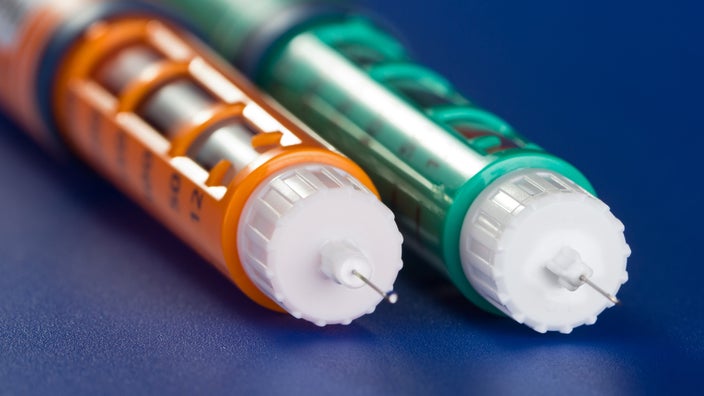
Trulicity vs. Ozempic: 5 Ways They Compare for Type 2 Diabetes
Key takeaways:
Trulicity (dulaglutide) and Ozempic (semaglutide) are once-weekly injectable medications used to treat Type 2 diabetes. They work in a similar way in the body to manage blood glucose (sugar) levels.
Ozempic may be more effective than Trulicity at lowering hemoglobin A1C — average blood glucose levels over a period of 3 months. It may also result in greater weight loss.
Both medications can help lower the risk of serious cardiovascular problems in certain people with existing heart disease. But Trulicity is approved for this use in people with heart disease or risk factors for heart disease.
Trulicity and Ozempic have several similarities. Your healthcare team may recommend one over the other based on your preference, medical history, or insurance coverage.
Table of contents

There’s a good chance you’ve heard the name Ozempic (semaglutide). But a few years before Ozempic hit the market, there already was Trulicity (dulaglutide). The two medications belong to the same class — glucagon-like peptide-1 (GLP-1) receptor agonists. But how do they compare?
Both medications are FDA-approved to treat Type 2 diabetes and lower the risk of serious cardiovascular problems. And they’re each also administered as a subcutaneous (under-the-skin) injection once a week. But there are some differences in how well they work and who can take them. Here are five ways Trulicity and Ozempic compare.
1. Trulicity and Ozempic work the same way for Type 2 diabetes
As mentioned above, Trulicity and Ozempic are both GLP-1 receptor agonists. Trulicity contains an active ingredient called dulaglutide, and Ozempic contains semaglutide. Both ingredients mimic the effects of natural GLP-1, which is a gut hormone in the body.
Save every month on GLP-1 meds with GoodRx
Save an average of $235 on FDA-approved GLP-1s like Ozempic and Zepbound.

GLP-1 receptor agonists such as Trulicity and Ozempic are thought to have a few key effects in the body, including:
Telling your pancreas to release insulin after you eat
Slowing the movement of food out of your stomach
Reducing glucose (sugar) production in your liver
Targeting the part of your brain that regulates appetite and fullness
Trulicity and Ozempic are both formulated to last a long time in the body. For this reason, you only need to inject your dose once per week.
2. Trulicity and Ozempic have slightly different approved uses
Trulicity and Ozempic are both FDA-approved for managing Type 2 diabetes. They’re also approved to lower the risk of major adverse cardiovascular events (heart attack, stroke, or cardiovascular death), or MACE, in specific groups. However, there are some differences in their approved populations.
Trulicity is approved for people age 10 and older with Type 2 diabetes. And it can lower the risk of MACE in people with existing heart disease or risk factors for heart disease.
Ozempic, on the other hand, is approved for adults with Type 2 diabetes. It’s also specifically indicated for reducing MACE risk in people with existing heart disease. The FDA also may approve Ozempic for chronic kidney disease in early 2025, which sets it apart from Trulicity.
How they compare: Ozempic and Trulicity belong to the same medication class, called glucagon-like peptide-1 (GLP-1) receptor agonists. Here’s how GLP-1 receptor agonists compare.
What to expect with Ozempic: One woman shares her experience with this diabetes medication and how it changed her relationship with food.
Weight changes: Ozempic and Trulicity are two diabetes medications that can result in weight loss. Here’s how other diabetes medications can affect body weight.
3. Ozempic may be more effective than Trulicity for Type 2 diabetes
Trulicity and Ozempic have been directly compared to each other during a clinical trial. The results showed that Ozempic lowered hemoglobin A1C (HbA1C or A1C) more than Trulicity. A1C is a test that measures your average blood glucose levels over 3 months.
The 40-week trial compared Trulicity (0.75 mg or 1.5 mg) with Ozempic (0.5 mg or 1 mg). People receiving the highest Trulicity dose had an average A1C reduction of 1.4%. This is compared to a 1.8% A1C reduction with the highest Ozempic dose.
However, it’s important to note that both medications are now available in doses that are higher than those compared in the trial. Ozempic is available in a 2 mg dose, while Trulicity comes in 3 mg and 4.5 mg doses. These doses haven’t been compared in studies.
Read more like this
Explore these related articles, suggested for readers like you.
4. Ozempic may result in greater weight loss compared with Trulicity
During the same clinical trial, Trulicity and Ozempic were compared directly for weight loss in people with Type 2 diabetes. The results showed that people receiving Ozempic (0.5 mg or 1 mg) lost more weight compared with those receiving Trulicity (0.75 mg or 1.5 mg). On average, the Ozempic group lost 10 to 14 lbs, while the Trulicity group lost 5 to 7 lbs.
Weight loss is possible with GLP-1 receptor agonists such as Trulicity and Ozempic. But neither medication is specifically approved for weight loss. However, a higher-dose version of semaglutide (the active ingredient in Ozempic) is sold as Wegovy for this purpose.
5. Trulicity and Ozempic have similar side effects and risks
Since they work the same way in the body, Trulicity and Ozempic also have similar side effects. Common side effects include:
Nausea and stomach upset
Vomiting
Abdominal pain
Reduced appetite
Fatigue
These side effects are usually worse when you first start Trulicity or Ozempic and after your dose is increased. But for many people, they improve over time and can be managed with dietary and lifestyle changes.
While less common, GLP-1 receptor agonists have been linked to more serious risks. Examples include thyroid C-cell tumors, pancreatitis, and gallbladder problems.
Can you use Trulicity and Ozempic at the same time?
No. Since Trulicity and Ozempic work the same way in the body, you’ll be prescribed one or the other — not both. If you need more help meeting your treatment goals, your prescriber may increase your dose. Otherwise, they may add another medication that works differently or have you switch treatments.
Can you switch from Trulicity to Ozempic?
Yes. It’s possible to switch from Trulicity to Ozempic. For example, your prescriber may switch you to Ozempic if you need more help managing your blood glucose or body weight. There’s no specific dose conversion table to follow. So, they may have you start with a lower Ozempic dose and work your way up to a dose that’s effective for you.
Frequently asked questions
Trulicity is still on the market. But due to high demand, it has been on the FDA shortage list since December 2022. All Trulicity doses are currently listed as “available.” But the FDA hasn’t determined yet that the manufacturer can meet the market demand to remove it from the list.
Mounjaro, a medication with the active ingredient tirzepatide that’s also used to treat Type 2 diabetes, has been directly compared with Trulicity in a clinical trial. The 52-week trial compared the 5 mg, 10 mg, and 15 mg tirzepatide doses with Trulicity 0.75 mg. The findings showed that Mounjaro lowered A1C levels in participants significantly more than Trulicity did. People receiving Mounjaro also lost more weight.
Generally, yes. You don’t need to taper off of Trulicity. But you shouldn’t stop Trulicity without speaking with your prescriber first.
The bottom line
Trulicity (dulaglutide) and Ozempic (semaglutide) are once-weekly injectable medications for Type 2 diabetes. They work the same way in the body. But studies suggest that Ozempic may have a greater impact on blood glucose and body weight.
Your prescriber can help determine if Trulicity or Ozempic is right for you. They’ll consider your health history, treatment goals, and insurance coverage, among other factors.
Why trust our experts?


References
Eli Lilly and Company. (2020). Trulicity (dulaglutide) is the first and only Type 2 diabetes medicine approved to reduce cardiovascular events in adults with and without established cardiovascular disease.
Eli Lilly and Company. (2024). Trulicity- dulaglutide injection, solution [package insert]. DailyMed.
FDA Drug Shortages. (2024). Current and resolved drug shortages and discontinuations reported to FDA.
Inagaki, N. (2022). Efficacy and safety of tirzepatide monotherapy compared with dulaglutide in Japanese patients with Type 2 diabetes (SURPASS J-mono): A double-blind, multicentre, randomised, Phase 3 trial. The Lancet: Diabetes & Endocrinology.
Novo Nordisk. (2024). Ozempic- semaglutide injection, solution [package insert]. DailyMed.
Pratley, R. E., et al. (2018). Semaglutide versus dulaglutide once weekly in patients with Type 2 diabetes (SUSTAIN 7): A randomised, open-label, Phase 3b trial. The Lancet: Diabetes & Endocrinology.
Tyson, A., et al. (2024). How Americans view weight-loss drugs and their potential impact on obesity in the U.S. Pew Research Center.





























